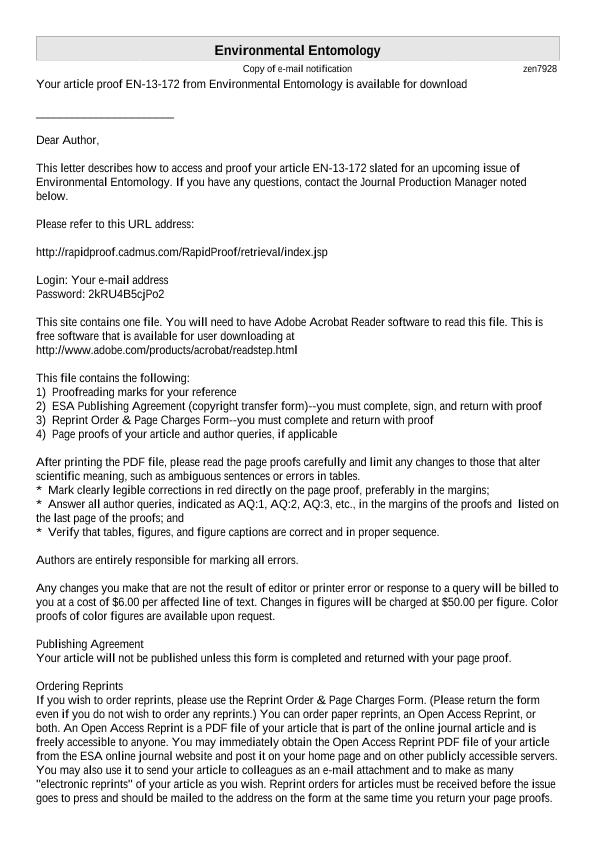Mostrar el registro sencillo del ítem
dc.contributor.author
Guillade, Andrea Cecilia

dc.contributor.author
Folgarait, Patricia Julia

dc.date.available
2018-01-15T19:48:16Z
dc.date.issued
2014-04
dc.identifier.citation
Guillade, Andrea Cecilia; Folgarait, Patricia Julia; Optimal Conditions to Rear Phorid Parasitoids (Diptera: Phoridae) of Atta vollenweideri and Acromyrmex lundii (Hymenoptera: Formicidae); Oxford University Press; Environmental Entomology; 43; 2; 4-2014; 458-466
dc.identifier.issn
0046-225X
dc.identifier.uri
http://hdl.handle.net/11336/33329
dc.description.abstract
Phorid flies have been considered viable options for biological control of leaf-cutter ants because they are highly specific to these hosts, producing direct mortality and also affecting the normal functioning of colonies. Designing protocols for mass rearing of these insects requires knowing the temperature and humidity conditions that optimize their development in terms of duration, survivorship and longevity of adults. We reared Apocephalus setitarsus Brown, Eibesfeldtphora trilobata Disney, and Myrmosicarius brandaoi Disney, which are specific leaf-cutter ant parasitoids of Atta vollenweideri Forel, and Apocephalus neivai Borgmeier and Myrmosicarius catharinensis Borgmeier, which are parasitoids of Acromyrmex lundii Guérin-Méneville. Phorids were maintained under one of five different rearing conditions, 20°C high humidity (20HH), 24°C low and high humidity (24LH and 24HH), and 28°C low and high humidity (28LH and 28HH). Flies from all species could complete their development under all the conditions tested. As expected, the 20HH treatment significantly lengthened all developmental periods in all species, whereas the shortest duration was achieved under 28HH. Although pupal survivorship was highest at 24HH, the greatest longevity of adults was achieved at 20HH. Percentage of pupae obtained and pupal survivorship also exhibited the highest values at 24HH. The rearing efficiency index was highest for all species at 24HH. Therefore, we suggest this temperature and humidity combination as the most suitable for rearing these species, whereas the 20HH treatment is ideal for maintaining adults for longer periods, which would be advantageous for synchronizing matings and mass releases of adults in the field.
dc.format
application/pdf
dc.language.iso
eng
dc.publisher
Oxford University Press

dc.rights
info:eu-repo/semantics/openAccess
dc.rights.uri
https://creativecommons.org/licenses/by-nc-sa/2.5/ar/
dc.subject
Phoridae
dc.subject
Leaf-Cutter Ant
dc.subject
Temperature
dc.subject
Humidity
dc.subject.classification
Otras Ciencias Biológicas

dc.subject.classification
Ciencias Biológicas

dc.subject.classification
CIENCIAS NATURALES Y EXACTAS

dc.title
Optimal Conditions to Rear Phorid Parasitoids (Diptera: Phoridae) of Atta vollenweideri and Acromyrmex lundii (Hymenoptera: Formicidae)
dc.type
info:eu-repo/semantics/article
dc.type
info:ar-repo/semantics/artículo
dc.type
info:eu-repo/semantics/publishedVersion
dc.date.updated
2018-01-11T13:46:39Z
dc.identifier.eissn
1938-2936
dc.journal.volume
43
dc.journal.number
2
dc.journal.pagination
458-466
dc.journal.pais
Reino Unido

dc.journal.ciudad
Oxford
dc.description.fil
Fil: Guillade, Andrea Cecilia. Universidad Nacional de Quilmes. Departamento de Ciencia y Tecnología; Argentina. Consejo Nacional de Investigaciones Científicas y Técnicas; Argentina
dc.description.fil
Fil: Folgarait, Patricia Julia. Universidad Nacional de Quilmes. Departamento de Ciencia y Tecnología; Argentina. Consejo Nacional de Investigaciones Científicas y Técnicas; Argentina
dc.journal.title
Environmental Entomology

dc.relation.alternativeid
info:eu-repo/semantics/altIdentifier/doi/http://dx.doi.org/10.1603/EN13172
dc.relation.alternativeid
info:eu-repo/semantics/altIdentifier/url/https://academic.oup.com/ee/article-abstract/43/2/458/531998
Archivos asociados
